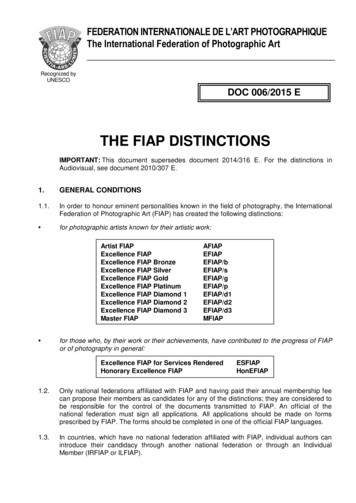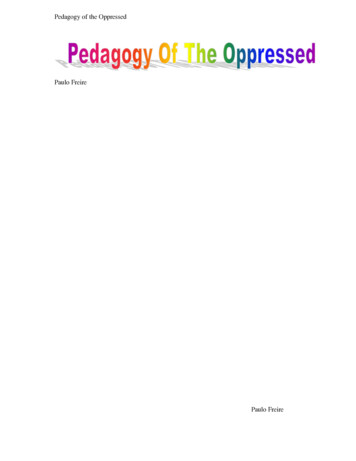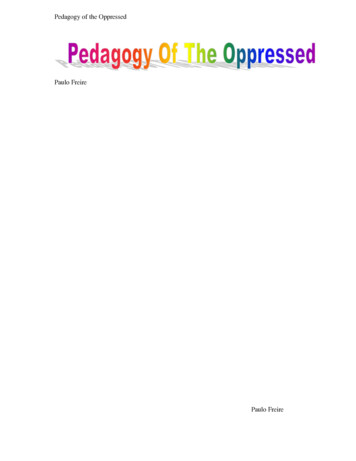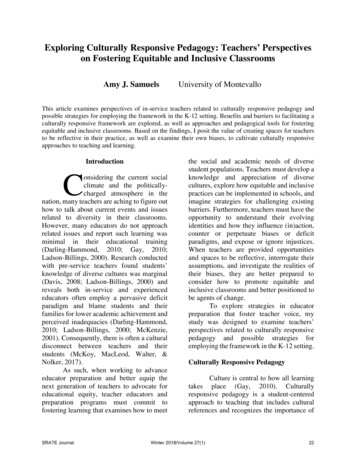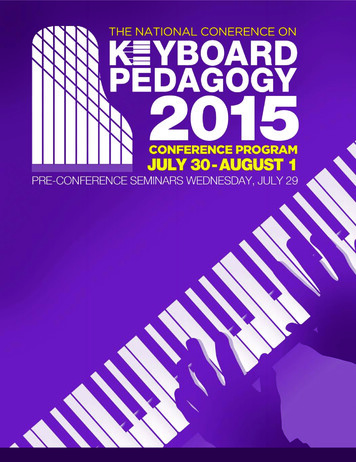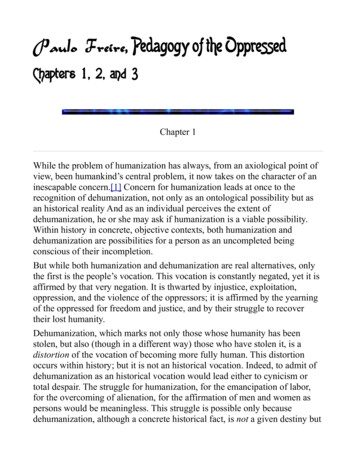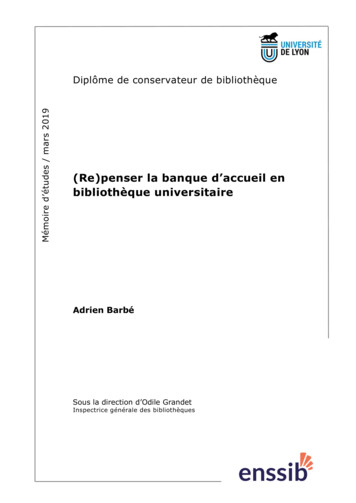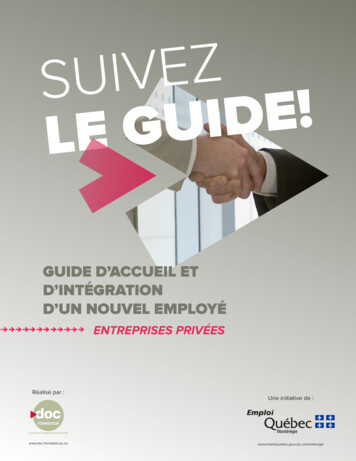
Transcription
"EXCELLENCEIN PEDAGOGY"ELECTIVESSPRING 20211
SUMMARYWEEK 1, JANUARY 11 TO 15 . 4Games and Strategies for Business . 5Strategies of value creation on the Internet . 7Wine & food tourism marketing . 9Management of Responsible Organizations "MORO" . 10Video Game Markets and Marketing . 12Microfinance . 14Strategic Management of Innovation (SMOFI) . 16Value and values of art markets: Organisation, economics, management and stakeholders. 18International Wine & Spirits Marketing/Communications with a focus on China . 21Cryptocurrencies and Blockchain’s technologies . 23The art and science of happiness . 25WEEK 2, JANUARY 18 TO 22 . 27Marketing for Entrepreneurs . 28International Finance . 29Cross-Cultural Management . 31Global Business . 33Entrepreneurship, Management and Business Strategy in the Global Context . 34Introduction to Project Management . 35Doing Business in Latin America . 37Becoming a Cultural Leader . 39General Management Simulation . 41On Branding in Times of Crisis . 42Corporate Finance. 44Global Leadership of Altruism beyond COVID-19 . 45WEEK 3, JANUARY 25 TO 29 . 48Fundamentals of Entrepreneurship . 49New Product Development . 51Luxury Branding Management . 53Strategic Management and Business Model Innovation . 54Sports Marketing in the Context of Globalization . 55Business Opportunities in Emerging Markets. 58Reputation Management for the Modern Business . 59Managing change and transformation of archaic industries in VUCA environment . 61Develop your soft skills: the key to success in the business world . 622
Strategic Foresight for Digital Futures . 64The Psychology Behind Consumer Behavior. 66The Ethics of Conflicts of Interest in Business . 67WEEK 4, MARCH 15 TO 19 . 69Crisis Management . 70Managing Wine Tourism Services: Branding and Delivery. 73Entrepreneurship in Theory and Practice . 75International Management and Organizational Structures . 78Economics and Management of Urban Cultural Capital . 81Corporate Strategy and Sustainability . 83Leading for the Human Moment . 85Dealing with Uncertainty . 87Strategy, people and performance . 89Digital Marketing for Social Change . 91Social Entrepreneurship and Social Innovation. . 93Automation, Artificial Intelligence (AI) and Multinational Business . 96Applied Sustainability in the Real World: a roadmap between SDGs and Circularity . 99WEEK 5, MARCH 22 TO 26 . 101Fashion and Society . 102Investing in stock markets . 104Creating Value Through Customer Engagement. 105Leadership, Strategy, and Decision Making . 107Conflict Management Skills . 108Smartmarketing for Entrepreneurs . 110Decisions, emotions and uncertainty . 111Are Arts and Culture Organizations different from other organizations? . 114Intercultural Competences . 116Networks and International Strategic Alliances . 118Value Co-Creation in Sport Management . 120Strategic Decision Making for Managers in the Organizations . 122All course descriptions are provisional and can be subject to change.3
WEEK 1, JANUARY 11 TO 154
Master Grande École 2020-2021Module's Title:Games and Strategies for BusinessSubject area / specialisation:Behavioural EconomicsPedagogy:Distance learning onlyRoberto alezProfessor:Burgundy School of BusinessLearning objectives:To develop an understanding of the key concepts, models and tools of the theory of games. To investigatethe application of decision and game theory to business decision making.This module develops a knowledge and understanding of:Knowledge and understanding Markets - the development and operation of markets for resources, goods and servicesPeople - the management and development of people within organisationsBusiness policy and strategy - the development of appropriate policies and strategies within achanging environment, to meet stakeholder interests Pervasive issues - these would include sustainability, globalisation, corporate social responsibility,diversity, business innovation, creativity, enterprise development, knowledge management and riskmanagement The ethical dilemmas and corporate social responsibility issues that arise when ethical andorganisational values are applied to situations and choicesIntellectual skills Being able to think critically and be creative: manage the creative processes in oneself and others;organise thoughts, analyse, synthesise and critically appraise. This includes the capability to identifyassumptions, evaluate statements in terms of evidence, detect false logic or reasoning, identifyimplicit values, define terms adequately and generalise appropriately Being able to solve complex problems and make decisions: establish criteria, using appropriatedecision-making techniques including identifying, formulating and solving business problems; andthe ability to create, identify and evaluate options; the ability to implement and review decisionsProfessional practical skills The ability to conduct research into business and management issues either individually or as partof a team through research design, data collection, analysis, synthesis and reportingEffective performance within team environments and the ability to recognise and utilise individuals'contributions in group processes and to negotiate and persuade or influence others; team selection,delegation, development and managementLeadership and performance management: selecting appropriate leadership style for differentsituations; setting targets, motivating, monitoring performance, coaching and mentoringDescription of Content: Decision making Risky decisions Decision errors Simulation games5
CoordinationCooperationSequential gamesStrategic movesSocial preferencesAuctionsAssessment: A 2,000 words essayTeaching Method: Lecture Classroom experimentsBibliography:There are a number of good books which cover the material in this module. For the game theory parts ofthe module, I particularly recommend the following: Dixit, A. K. and B. J. Nalebuff (2008): The Art of Strategy: A Game Theorist's Guide to Success inBusiness and Life. New York: WW Norton & Company. (AS) Dixit, A. K. and S. Skeath (1999): Games of strategy. New York: WW Norton & Company. (GOS) Dixit, A. K. and B. J. Nalebuff (1991): Thinking strategically: The competitive edge in business, politics,and everyday life. New York: WW Norton & Company. (TS) McMillan, J. (1996): Games, strategies, and managers. Oxford University Press. (GSM) Miller, J. D. (2003). Game theory at work. McGraw Hill. (GAW)GOS is a textbook which covers most of the theoretical concepts discussed in this module. AS, TS, GSMand GAW are managerial game theory books with many cases and applications of game theory tobusiness. The game theory books do not deal well with the psychological aspects of choice discussed inclass. For these I recommend Wilkinson, N., and M. Klaes (2012): An introduction to behavioral economics. Palgrave Macmillan.Plous, S. (1993): The psychology of judgment and decision making. Mcgraw-Hill Book Company.Thaler, R. H. and C. S. Sunstein (2008): Nudge: Improving Decisions about Health, Wealth, andHappiness. Yale University Press.Ariely, D. (2008): Predictably irrational. New York: HarperCollins.Kahneman, D. (2011): Thinking, fast and slow. Macmillan.Russo, J. E. and P. J. Schoemaker, P. J. (1989): Decision traps: Ten barriers to brilliant decision-makingand how to overcome them. New York: Doubleday.6
Master Grande École 2020-2021Module's Title:Strategies of value creation on the InternetSubject area / specialisation:MarketingDistance learning onlyDjamchid tion.comBurgundy School of BusinessLearning objectives:At the completion of the course, students should be able to:1)2)3)4)5)6)7)Explain the founding concept of value creation in the cyberspace of the InternetProvide insights on how to implement strategy in the New Economy.Discern the strategic business models of value creation on the InternetUnderstand the potentials of the Internet for marketing strategies and customer satisfactionUnderstand what Web 2.0 is all about and the P2P revolutionUnderstand some legal and ethical issues related to E-BusinessWork in teams and communicate in public.Description of Content: Course Presentation - Introduction e-business - Teams Formation"Fluid" Consumer behaviour - Strategies of consumer journey - Teams work presentation anddiscussionWhat is a business model? - What are the components of a business model? – Customer ValueProposition and Income Stream - Teamwork presentation and discussionTechnological Infrastructure and Governance - Teamwork presentation and discussionBusiness models of selling tangible and intangible products online - Theory of Long Tail - Teamworkpresentation and discussionBig data and business model of infomediation - Big data analytics - Teamwork presentations anddiscussionTypology of social media - Social media strategy - Team work presentations and discussionBusiness model of exchange facilitation - Crowdsourcing and crowdfunding online - Teamworkpresentations and discussionBrands say, People say - Brand strategies in face of social media - Workshop Presentations andevaluationAssessment:The final grade will be based on: Course Work - Workshop preparation and presentation (50%) Final Exam – Personal term project (50%)Teaching Method: This course aims to provide with insights and frameworks an understanding of thedynamism of the cyberspace for business and commerce. The teaching approach gives a balancedapproach of theoretical enlightenment and practical enrichment; and accordingly mixes: Lectures. Each session is opened by the professor’ lecture. Discussion. The professor will discuss the concepts and encourage questions and critical thinking. Workshops. Student teams will apply theories and concepts to practical cases.7
Bibliography: Reading and understanding of the following articles are Compulsory: Anderson Chris, “The Long Tail: Forget squeezing millions from a few megahits at the top of the charts.The future of entertainment is in the millions of niche markets at the shallow end of the bit stream",Wired, and October 2004.O’Reilly Tim, “What is Web 2.0. Design Patterns and Business Models for the Next Generation ofSoftware”Porter M. E. (2001), Strategy and the Internet, Harvard Business Review, MarchMoney from Friends: Finding the Right Revenue Model for Social Media, Knowledge@Wharton,August 29, 2012.Four ways to get more value from digital marketing, Published : March 2010, in McKinsey QuarterlyOnlineFurther readings: Transmedia Storytelling, Fan Culture and the Future of Marketing, Published : July 3, 2012 inKnowledge@WhartonErik Brynjolfsson, Yu Hu and Michael Smith, “From Niches to Riches: Anatomy of the Long Tail”Daniel G. Goldstein, Dominique C. Goldstein, “Profiting from the Long Tail”The course materials also include the PPT slides available on e-learning online8
Master Grande École 2020-2021Module's Title:Wine & food tourism marketingSubject area / specialisation:MarketingDistance learning onlylaurence.cogan-marie@bsb-education.comLaurence CoganPedagogy:Professor:School of Wine & Spirits Business @ Burgundy School of BusinessLearning objectives: To learn the specificities of the food & wine industry; To identify the market segment to which food and wine tourism is targeted; To identify the profile of a oeno-gastro tourist; To understand the importance of marketing food & wine; To be able to clearly market a food site or a winery on a national or international level; To be able to identify business opportunities in this industry.Description of Content: Introduction to the food/wine tourism concept Profile of the oeno-gastro tourist Creating and managing a food & or wine tourism festival/event Role of the winery or the food production site in wine/food marketing and distribution Function of wine/food routes and trails Wine region brand building New trends in food & wine tourism Final project: designing an innovative food & or wine tourism conceptAssessment:Final project presentation (Group)Case study (Individual)Total5050100Teaching Method:The course is an experiential learning course designed around three fundamental concepts: Learning by doing (designing an innovative & realistic wine/food tourism project) Reflection in action (participation and class discussion) CoachingBibliography:"Global Wine Tourism, Research, Management & Marketing" by Jack Carlsen & Stephen Charters, edition2006.- "Wine Tourism around the world, Development, management and markets" by C. Michael Hall, LizSharples, Brock Cambourne, Niki Macionis, 2000.- "Wine, Food, and Tourism Marketing" (Journal of Travel & Tourism Marketing, Vol. 14, Numbers 3/42003) - C Michael Hall- "Food tourism around the world, Development, management and markets" by C. Michael Hall, LizSharples, Richard Mitchell, Niki Macionis & Brock Cambourne, 2003.- "Wine business management" by Steve Charters, Jérôme Gallo, Pearson, 2014.9
Master Grande École 2020-2021Module's Title:Management of Responsible Organizations "MORO"Subject area / specialisation:Management of organizationsDistance learning onlyMarc rd@bsb-education.comChristelle HavardPedagogy:Professor:School of Wine & Spirits Business @ Burgundy School of BusinessLearning objectives:Linked to the research activities of the Chair of Management and Responsible Innovations - MIR and theglobal strategy of the Burgundy School of Business, the main learning goals of this course are the following: Understand concepts and associated practices linked to responsible management and innovationsAnalyse the responsibility of organizations at the levels of strategy, environment, innovations andmanagementStudy the implications and recommendations for future managersMain targeted competencies and skills developed – BSB Portfolio: MGE GK4.1 - To be acquainted with, to understand and to be capable of explaining the behaviour ofindividuals and groups within organizations MGE GK4.2 - To be acquainted with and to understand the principal dimensions of the analysis oforganizations MGE GS1 - To know how to analyse and solve a problem and to know how to structure one’s thinking MGE GS3 - To show open-mindedness and integrity MGE GS3.5 To be sensitive to corporate social responsibility and to behave in a responsible mannerDescription of Content: Session 1: Introduction to Corporate Social Responsibility in Organizations by Marc Ingham Session 2: Responsible Innovations in Organizations Session 3: Social Responsibility of Organisations and responsible Managers by Christelle Havard Session 4: Strategic Integration of Responsible Management and Innovations by Marc Ingham(Supported by Christelle Havard to help student to prepare their case study) Session 5: Mini Cases Presentations and Conclusions by Christelle Havard and Marc InghamAssessment:1- Individual final exercise: Each student will present a personal reflection on their experience of thecourse (30%)Main ideas drawn from the texts to be read, complementarity between texts and contents ofthe course, the complementarity between the knowledge stemming from texts and from theclass on one hand and construction of a mini-case on the other hand, what the course allowedto bring to the knowledge of the responsible organizations and to the critical glance which wecan concern the Corporate Social Responsibility2- Collective Group worka. Dossier: building a mini-case of a responsible organization (40%)b. Presentation of this mini-case during the last session (30%)10
Teaching Method:This course is based on advanced pedagogical methods based the combination and integration of variousresources to sustain and strengthen the learning process and outcomes: - Mandatory readings, - Cases andillustrations (ex: La Poste, SEB, Triodos, Jegay Lagoute, Salomon, Patagonia, ) - Videos, - E-learning, - Linksto web sites (Harvard, Insead, Stanford, MIT, ), Individual readings, -Group presentations on mini-caseprojects, Group report and active interactions during the sessions.Participants will work in groups on a mini-case project that will be presented and discussed during the finalsession.Bibliography:Compulsory reading:Maon, F., Lindgreen, A., Swaen, V., (2008). Designing and Implementing Corporate Social Responsibility:An Integrative Framework Grounded in Theory and Practice, Journal of Business Ethics, Vol. 87, pp.71-89.Del Rio-Gonzales, P., (2009). The Empirical Analysis of the Determinants for Environmental TechnologicalChange: A Research Agenda, Ecological Economics, Vol. 68, pp. 861-878.Baumann-Pauly, D., Wickert , C., Spence, L., Scherer, A. G., (2013). Organizing Corporate SocialResponsibility in Small and Large Firms: Size Matters, Journal of Business Ethics, Vol. 115, pp. 693705.Gond, J.-P., Igalens, J., Swaen V., El Akremi, A., (2011). The Human Resources Contribution to ResponsibleLeadership: an Exploration of the CSR-HR Interface, Journal of Business Ethics, Vol. 98, pp.115-132.Complementary readings available on Elearning:Garriga, E., Melé, D., (2004). Corporate Social Responsibility Theories: Mapping the Territory, Journal ofBusiness Ethics, Vol. 53, pp. 51-71.Porter, M., Kramer, M., (2011). Creating Shared Value – How to Reinvent Capitalism-and Unleash a Waveof Innovation and Growth, Harvard Business Review, Jan.-Feb. 2011, pp. 1-17.Horbach, J., Rammer, C., Rennings, K., (2012). Determinants of Eco-Innovations by Type of EnvironmentalImpact — The Role of Regulatory Push/Pull, Technology Push and Market Pull, Ecological Economics,Vol. 78- pp 112-122De Marchi, V., (2012). Environmental Innovation and R&D Cooperation: Empirical Evidence from SpanishManufacturing Firms, Research Policy, Vol. 41, pp. 614– 623.Birkinshaw, J., Hamel, G., Mol, M., (2008). Management Innovation. Academy of Management Review,Vol. 33, No. 4, pp. 825-845.Mol, M., Birkinshaw, J., (2009). The Sources of Management Innovation: When Firms Introduce NewManagement Practices. Journal of Business Research, Vol. 62, pp. 1269-1280.Sharma, S., Sharma, J., Devi, A., (2009). Corporate Social Responsibility: the Key Role of Human ResourceManagement, Business Intelligence Journal, January, pp. 205-212.L'Etang, J., (1995). Ethical Corporate Social Responsibility: A Framework for Managers, Journal of BusinessEthics, Vol. 14, pp. 125-132.11
Master Grande École 2020-2021Module's Title:Video Game Markets and MarketingSubject area / specialisation:Pedagogy:MarketingDistance learning comBurgundy School of BusinessMathieu-Claude ChaboudLearning objectives: This course is dedicated to the exploration of all aspects of the video game industry markets.To gain market specific knowledge about the industry and its components.To learn about game product development and funding related to markets and distribution.To understand its specific consumers segments and the typologies of other stakeholders.Description of Content:Block 1: Introduction to video game markets The structure of video game industry Publishers Studios Independents companiesBlock 2: Video game consumers From hardcore to casual gamers and everything in between Archetypal genres and the question of gameplay Franchises, AAA and indie successesBlock 3: Market structures in the video game industry Distribution Brick & mortar and dematerialised platforms PC, console and mobile marketsBlock 4: Customer relationships and long term success Funding projects Legitimacy and consumer adoption Social media and web 2.0 effects The free-to-play revolutionBlock 5: Piracy and anti-piracy in the video game industry Intellectual property protection Grey markets and piracy channels Network externalities and the impact of piracy Legacy video gaming: exploitation, use and abuseAssessment:Final case studyParticipation/AttendanceTotal752510012
Teaching Method:In addition to lectures, the course is an experiential learning course designed around three fundamentalconcepts: Learning by doing (final case study)Reflection in action (participation and class discussion)CoachingBibliography:All readings and materials will be provided by the instructor.13
Master Grande École 2020-2021Module's Title:MicrofinanceSubject area / specialisation:FinancePedagogy:Distance learning onlyArvind ndy School of BusinessLearning objectives: To look at Microfinance institutions from different perspectives and understand how they work, whythey work, and what is required of them in terms of strategy in the wake of sustainability anddevelopment objectives.Supplementary objectives are developing management skills in group work and team leading as wellas the ability to appreciate corporate governance and business ethics issues within this field.To know how to carry out retrospective analysis on the governance of a firm and business ethicsDescription of Content: Microfinance is a fast growing sector known for two key features: profitability and providing Financialinclusion.The course outlines the amazing growth of the microfinance institutions, their diverse businessmodels, the sociological and management issues raised in managing these organizations and theirmarkets, and the role of technology in promoting the growth. It looks at some aspects of riskmanagement in the portfolios of socially responsible investment funds as well as governance issuesraised by the involvement of global financial and non-governmental institutions. While the focus ispredominantly on microcredit, other forms of microfinance will also be discussed. Finally, newtechnological developments are ushering in cloud computing, crowdfunding and mobile banking andthe course will help students understand the opportunities as well as the risks of using high technology.You will be required to develop the strategy of a microfinance institution.Assessment: Answering a question based on a book to be read before coming to class (20%)Problem Based Learning (50%)Final Quiz (30%)Teaching Method: The course is a mixture of classes, including a visiting professor from the field, and problem basedLearning.The course places equal emphasis on lectures with active discussion, extensive reading, and groupwork to build team skills.A Book Review is an additional tool used to the normal ones ticked below.The PBL approach requires highly intensive discussions between group members and a willingness toprovide feedback to each other. It will be based on a case. You will be provided a country to invest inand have to formulate the complete strategy of entering the microfinance market in that country. Highpressure targets may require working till late at night.14
Bibliography:Books:Yunus, M. (2003). Banker to the Poor: Micro-Lending and the Battle Against World Poverty, . New York,Public Affairs.Armendàriz, B. and J. Morduch (2010). The Economics of Microfinance. Cambridge, MA, MIT Press.Ashta, A., Ed. (2011). Advanced technologies for microfinance: Solutions and challenges. Hershey, PA, IGIGlobal.Armendariz, B. and M. Labie, Eds. (2011). The Handbook of Microfinance. Singapore, World Scientific.Papers:Ashta, A. (2009). "Microcredit Capital Flows and Interest Rates: An Alternative Explanation." Journal ofEconomic Issues (M.E. Sharpe Inc.) 43(3): 661-683.Ashta, A., K. Dayson, R. Gera, S. Hettihewa, N. V. Krishna and C. Wright (2013). Microcredit as a SocialInnovation. The International Handbook on Social Innovation. F. Moulaert, D. MacCallum, A. Mehmoodand A. Hamdouch. Cheltenham, UK., Edward Elgar: 80-93.
8 Bibliography: Reading and understanding of the following articles are Compulsory: Anderson hris, The Long Tail: Forget squeezing millions from a few megahits at the top of the charts. The future of entertainment is in the millions of niche markets at the shallow end of the bit stream",
